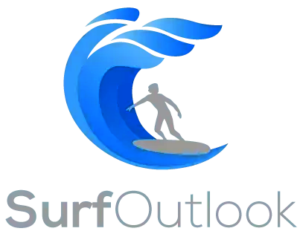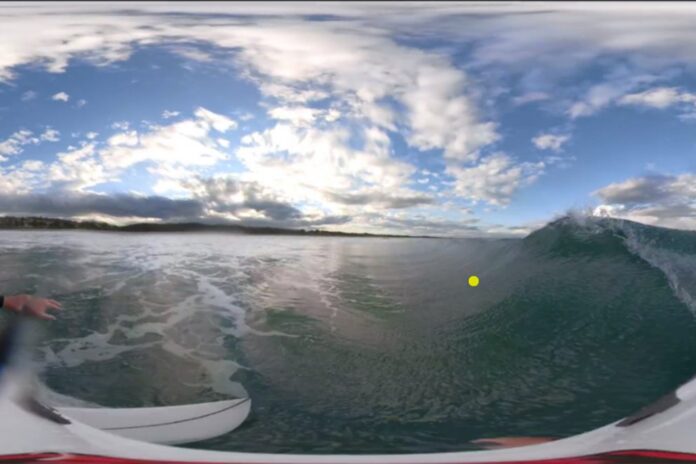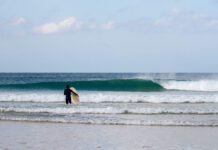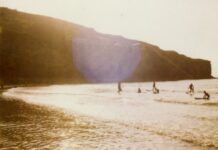As for the case of 360-degree video helping to maximise a surfer’s psychological readiness, the likelihood of harm increases for surfers who are not psychologically prepared for those higher-risk conditions such as riding large waves. Higher waves that induce a greater fear-response may detrimentally impair one’s physical and cognitive performance, and decrease the likelihood of the surfer safely riding a wave to their full potential. To this end, 360-degree video may be used to expose surfers to new and gradually fear-inducing scenarios appropriate to their individualised needs (e.g., high waves, unfamiliar competition locations). This could effectively attenuate the risk-of-harm by preconditioning surfers to novel and threatening environments. Waves of varying heights and intensities can be pre-filmed, then gradually provided to athletes for viewing to decrease their anxiety over time.
One final point about these approaches described is that surfers spend a vast amount of time just waiting for waves to catch. One bad weather event could disrupt weeks of planned training sessions, costing valuable time that could be spent focusing on skills training. Surfers would benefit greatly from utilising high-tech tools to bridge the gap between sessions.
As a surfer, did you experience any changes in the way you use your vision whilst surfing after this research?
Personally, I’m not a committed surfer, and some surfers who read this would see it as a huge limitation! My response to this is that I grew up surrounded by crocodiles at the top-end of Australia, so going ‘into’ the water is still considered madness to me. However, I’ve been a kayak guide for about 10 years, doing ocean tours and leading adult and kids camps; that’s the extent of my ocean-going experience. I was also an obsessive skateboarder. I say this because the skills required for success in these sports/ hobbies have some degree of overlap with surfing, and gives me a greater appreciation for what surfers go through on their unique surf-development journey.
Still, I do have one observation I noticed following the study. This was a realisation I had after kayaking with novice kayakers on a 55km kayaking and camping trip. Essentially, I noticed simple visual behaviours that many experts seem to share, whether they be expert surfers, skaters, or kayakers. In these sports, as well as many others, looking to the area nearest to oneself (e.g. the feet) often signifies a novice performer who is unstable and seeking visual cues to promote balance. On the other hand, looking away from the self and deep into the performance area (to a wave, some rapids, or skate ramp) signifies an experienced performer who has attained automaticity over these basic balance needs.
From a cognitive perspective, expertise develops through attaining this automaticity; it is a fast and efficient form of processing requiring few attentional resources. Importantly, automaticity frees up attentional resources that can be used elsewhere, such as peering around the performance environment and planning your next move. Therefore, expert surfers that have attained automaticity over simple balance requirements should spend more time looking to distant areas (such as desirable sections of a distant wave) and do not need to look to the immediate surroundings to successfully remain upright. This balancing-act just happens without looking, and seemingly without any thought involved.
Although this is a very simple observation, it’s interesting to think that this visual behaviour may be one of the many indicators differentiating levels of expertise for many types of sports. I think that, on a difficulty scale of juggling one’s balance while also visually exploring for performance information, surfing would be at the farthest end, up there with the most difficult sports in the world. There are very few sports that require a surfers’ level of cognitive gymnastics. Funnily enough, we saw that experts in the surf simulation were also peering outward, confidently, in this manner, whereas novices were naturally drawn to gazing toward areas around their feet and the surfboard. That said, I should note that this was our general interpretation, not an outcome that was analysed and found as such – but are more general observations of the video results.
Is there a next step for this study?
A few ideas for follow-up projects were in development, but these have been put on hold for the time-being due to Covid and becoming a full-time Dad. One idea was to explore the wave-related environmental cues that tell surfers whether a wave is surfable or not, and then, employ this gained information within a surf skills training program to see whether novice and intermediate surfers can directly benefit from the information whilst showing the transfer of skill. This project was parked aside, and I will have to consider whether to return to this in the future.
As for my unrealistic, super-futuristic expectations for this entire area of research (that I hope will be achieved within a decade)…
I made an earlier point about how difficult it is to find repeatable, identical, real-world waves – yet the new generation of artificial wave machines might be a solution to this problem. A hypothetical study could obtain world-class eye-tracking glasses and house them in waterproof cases, which could be attached to and powered by high-speed laptops fitted into waterproof cases carried in backpacks (similar to Red Bull’s project). This configuration could then be used by novice, intermediate, and expert surfers – a vital comparison that has never been performed. All surfers would perform straight runs and free-surfing runs along the artificial waves at a wave park that can provide moderate to large waves. The hope would be that the artificial waves are near-identical to each other, which would provide researchers with well-controlled conditions resulting in highly reliable side-by-side comparisons for the differing levels of expertise. This would result in an overwhelming amount of information about what surfers are doing with their eyes and when, thus revealing masses of knowledge about expert surfers’ visual-perceptual behaviour. The full gamut of visual data could be analysed: fixations, saccades, and potential to discover whether ‘quiet-eye’ visual behaviours exist for surfing.
**********
The author and Surf Simply would like to thank Professor Ian Luke for his assistance in the article.
Reference: Ian M. Luke, David L. Neumann, Matthew J. Stainer, Leigh Ellen Potter, Robyn L. Moffitt, Eye-gaze behaviour of expert and novice surfers in a simulated surf environment,
Psychology of Sport and Exercise, Volume 62, 2022, 102221, ISSN 1469-0292, https://doi.org/10.1016/j.psychsport.2022.102221.





